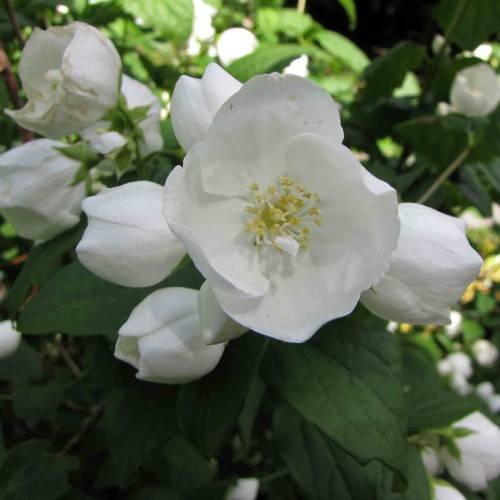
mock orange
Philadelphus virginalis
Cycle:
Perennial
Watering:
Average
Hardiness Zone:
5 - 8
Flowers:
Flowers
Sun:
Full sun,part shade
Leaf:
Yes
Growth Rate:
High
Maintenance:
Low
Drought Tolerant:
Yes
Care Level:
Medium
watering
Mock orange (Philadelphus virginalis) is a bush that thrives in moist, well-drained soil and full sun. It tolerates partial shade but flowers best when in full sun. When watering the mock orange, thoroughly soak the soil until the water drains from the bottom of the pot. During the first few weeks after planting, water the bush deeply once a week, allowing the soil to dry out slightly between waterings. You can gradually decrease the amount of water, but be sure to check the soil regularly by sticking your finger in it to be sure that it is still moist. Once the mock orange is established, water it deeply once every 7-10 days, or whenever the soil feels dry about 1 inch below the surface. If you are growing mock orange in a pot, you may need to water more frequently than if it was planted in the ground. During the hot summer months, you may need to water the mock orange twice a week, depending on the conditions. In winter, reduce the amount of water to once every couple of weeks. Overall, the key to keeping your mock orange healthy is to provide it with consistent moisture while taking care not to let the soil get too dry or too soggy.
sunlight
For optimal growth, mock orange (Philadelphus virginalis) plants should receive between 4 and 6 hours of direct sunlight per day. Late morning sun, when the sun is not too strong, is the best for mock oranges. If planted in a shaded area, the mock orange may not bloom as well. In hot climates the plants should be planted in areas that receive some afternoon shade.
pruning
Mock orange (Philadelphus virginalis) is a deciduous shrub that produces fragrant white flowers in the summer. Pruning should be done in late winter or early spring, before the plant starts to grow in the spring. Pruning can help to control the size and shape of the shrub, as well as remove dead or damaged branches. To maintain a healthy shape and blooms, the shrub should be pruned lightly to remove 1/3 of the oldest stems, leaving the new growth intact. Be sure to make your cuts clean and angled away from the bud on the stem so that new growth is directed outward rather than inward. Prune any misplaced shoots that are growing too far over and also any crossing branches or branches growing in towards the center of the plant.
